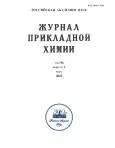Novel Halochromic Disazo Stilbene Dye with Intramolecular Color Mixing Effect for Textile Sensor Material
- Авторлар: Efanov S.A.1,2, Kudryavtseva T.N.1,3, Grekhneva E.V.1, Kuznetsov D.N.2
-
Мекемелер:
- Kursk State University
- Kosygin Russian State University (Technology. Design. Art)
- Kursk State Medical University
- Шығарылым: Том 96, № 3 (2023)
- Беттер: 245-251
- Бөлім: Articles
- URL: https://journals.rcsi.science/0044-4618/article/view/247282
- DOI: https://doi.org/10.31857/S0044461823030027
- EDN: https://elibrary.ru/PIIOHN
- ID: 247282
Дәйексөз келтіру
Толық мәтін
Аннотация
A stilbene-based halochromic dye was synthesized, which possesses the effect of intramolecular color matching. By dyeing cotton fabric with the synthesized dye, a textile sensor material was prepared to visually monitor the acidity of the biologically significant pH range (4.5–8.0). The sensitivity of the sensor material to changes in the acidity of the environment, as well as the color stability to the action of saline solutions simulating biological fluids (sweat and blood plasma), were explored. A visually noticeable pH-induced color change of the material is observed in the pH range of 3.0–10.0. In the pH range of buffer solutions at pH 3, the color of the samples is green, from 6 to 8, orange, and from 9 and above, purple. The average color change time was 3 s. The results obtained show the promise of using the studied azo compound in technologies for designing multifunctional pH-sensitive textile sensor materials.
Авторлар туралы
S. Efanov
Kursk State University; Kosygin Russian State University (Technology. Design. Art)
Email: acjournal.nauka.nw@yandex.ru
305000, Kursk, Russia; 119071, Moscow, Russia
T. Kudryavtseva
Kursk State University; Kursk State Medical University
Email: acjournal.nauka.nw@yandex.ru
305000, Kursk, Russia; 305041, Kursk, Russia
E. Grekhneva
Kursk State University
Email: acjournal.nauka.nw@yandex.ru
305000, Kursk, Russia
D. Kuznetsov
Kosygin Russian State University (Technology. Design. Art)
Хат алмасуға жауапты Автор.
Email: acjournal.nauka.nw@yandex.ru
119071, Moscow, Russia
Әдебиет тізімі
- Michele Caldara M., Colleoni C., Guido E., Re V., Rosace G. Optical monitoring of sweat pH by a textile fabric wearable sensor based on covalently bonded litmus-3-glycidoxypropyltrimethoxysilane coating // Sens. Actuators B. 2016. V. 222. P. 213-220. http://doi.org/10.1016/j.snb.2015.08.073
- Morris D., Coylea S., Wu Y., Laua K. T., Wallace G., Diamond D. Bio-sensing textile based patch with integrated optical detection system for sweat monitoring // Sens. Actuators B. 2009. V. 139. P. 231-236. http://doi.org/10.1016/j.snb.2009.02.032
- Van der Schueren L., De Clerck K. Coloration and application of pH-sensitive dyes on textile materials // Color. Technol. 2012. V. 128. N 2. P. 82-90. http://doi.org/10.1111/j.1478-4408.2011.00361.x
- Van der Schueren L., De Clerck K. The Use of pH- indicator dyes for pH-sensitive textile materials // Text. Res. J. 2009. V. 80. N 7. P. 590-603. http://doi.org/10.1177/0040517509346443
- Grad M. E., Simu G. M., Muntean S. G., Ilia G. Synthesis, characterization and colour determination using CIELAB colour space of stilbene dyes //j. Iran. Chem. Soc. 2013. V. 10. N 4. P. 807-816. http://doi.org/10.1007/s13738-012-0216-y
- Ильина А. В., Атрепьева Л. В., Ефанов С. А. Исследование свойств стильбенового аналога красителя Конго красного // Auditorium. Электрон. науч. журн. Курского гос. ун-та. 2022. № 3. С. 27-29. https://www.elibrary.ru/hmqlty
- Лозинская Е. Ф., Атрепьева Л. В., Григорьян А. Ю. Наумова Н. А., Гапеева В. А. Определение констант депротонизации бисазокрасителей на основе стильбендисульфокислоты, имеющих в составе структурные фрагменты фенола и резорцина // Auditorium. Электрон. науч. журн. Курского гос. ун-та. 2016. № 2. С. 8-14. https://www.elibrary.ru/wcyeqb
- Александрова Г. Ю., Алексанян К. Г., Меньшова И. И. Влияние разобщающей группы на цвет и свойства азокрасителей //Башкир. хим. журн. 2013. Т. 20. № 1. С. 84-88. https://www.elibrary.ru/qzjqcl
Қосымша файлдар









